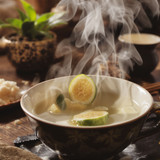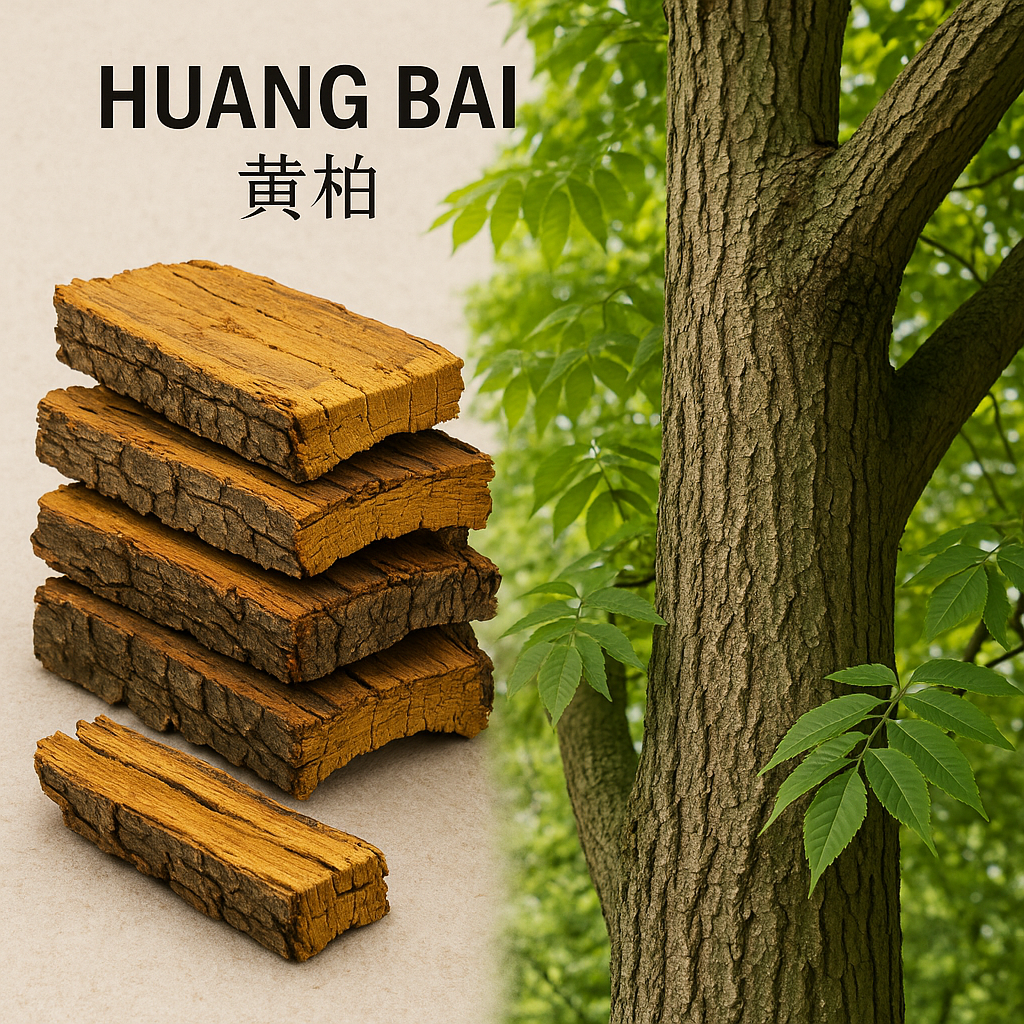

Starwest Botanicals
Organic White Tea Bags
White Tea Bags vs. Green Tea: Why They’re Different White tea and green tea come from the same plant—Camellia sinensis—but they’re made differently. That difference in processing is why white tea...
 Is your body sending out signals of heat, infection, or chronic irritation from deep within? Whether you're battling UTIs, inflammation, or frustrating skin eruptions, Huang Bai (Phellodendron Bark) has been the go-to solution in Traditional Chinese Medicine for over 2,000 years. This cooling, bitter bark works from the ground up—literally—focusing on the lower body to drain dampness, clear heat, and help your body recover its natural balance. Let’s explore what makes Huang Bai a standout herb in both ancient practice and modern clinical studies.
Is your body sending out signals of heat, infection, or chronic irritation from deep within? Whether you're battling UTIs, inflammation, or frustrating skin eruptions, Huang Bai (Phellodendron Bark) has been the go-to solution in Traditional Chinese Medicine for over 2,000 years. This cooling, bitter bark works from the ground up—literally—focusing on the lower body to drain dampness, clear heat, and help your body recover its natural balance. Let’s explore what makes Huang Bai a standout herb in both ancient practice and modern clinical studies.
Huang Bai (Phellodendron Bark) is a cold, bitter herb in Traditional Chinese Medicine used to clear damp-heat, especially in the lower body. It supports urinary tract health, soothes infections, relieves night sweats, and reduces inflammation. Backed by clinical research and TCM, it’s ideal for conditions like UTIs, skin eruptions, and Yin-deficiency heat.
| Feature | Details |
|---|---|
| Pin Yin Name | Huang Bai (黄柏) |
| Botanical Name | Phellodendron amurense |
| Common Names | Phellodendron Bark, Amur Cork Tree Bark |
| TCM Category | Herbs That Clear Heat and Dry Dampness |
| Meridians Entered | Kidney, Bladder, Large Intestine |
| Taste | Bitter |
| Temperature | Cold |
| Dosage | 3–12g in decoction; varies in powders/extracts |
| Contraindications | Deficiency-cold conditions, weak digestion |
| Used For | Damp-heat in lower jiao, urinary infections, skin eruptions, Yin deficiency with heat, diarrhea |
Huang Bai, or Phellodendron bark, is one of the “Three Yellow Brothers” in Chinese Medicine (alongside Huang Lian and Huang Qin). Known for its bold bitter taste and powerful cooling nature, Huang Bai is specifically celebrated for its focus on the lower jiao.
It’s a modern powerhouse for:
Urinary tract infections (UTIs)
Vaginal discharge or yeast infections
Damp-heat skin conditions
Night sweats and Yin-deficiency heat
Gut inflammation or loose stools from damp-heat
In Traditional Chinese Medicine (TCM), Huang Bai (Phellodendron Bark) is considered a bitter and cold herb that primarily enters the Kidney, Bladder, and Large Intestine meridians. Its therapeutic effects revolve around clearing damp-heat, draining Kidney fire, and eliminating toxic heat, especially in the lower jiao—the lower part of the torso that includes the urinary, reproductive, and intestinal systems.
Let’s break down how Huang Bai functions according to TCM theory:
In TCM, damp-heat refers to a combination of internal moisture retention (dampness) and excessive internal heat. This combination often results in:
Burning or painful urination
Yellow, cloudy, or strong-smelling urine
Vaginal discharge (thick, yellow, or odorous)
Loose stools with a foul smell or urgency
Genital itching or swelling
Damp skin eruptions (weeping eczema, oozing pustules)
Huang Bai has a drying and cooling nature, which makes it particularly effective for conditions in the lower body. It works by clearing heat and eliminating moisture from tissues, helping to:
Restore proper urination
Dry excessive vaginal discharge
Soothe intestinal inflammation
Reduce damp skin infections
It is commonly used in formulas for urinary tract infections (UTIs), yeast infections, pelvic inflammation, and chronic diarrhea due to heat.
When Yin energy (which cools and moistens the body) becomes deficient, it can no longer anchor the Yang (heat/fire), leading to signs of internal heat. This is often referred to as Kidney fire or Yin deficiency fire.
Symptoms include:
Night sweats
Hot flashes (especially during menopause)
Insomnia with heat sensations
Tidal fevers (feeling hot in late afternoon/evening)
Red tongue with little coating
Dry mouth, especially at night
Soreness in the lower back and knees
Huang Bai drains this false heat and restores balance by cooling the body and directing the heat downward and out through the bladder. It is a key herb in managing conditions where heat rises due to a lack of internal cooling fluids (Yin).
Toxic heat refers to a TCM pattern where the body’s internal systems are overwhelmed by excess heat and pathogens. This is often seen in:
Skin infections with pus
Boils, carbuncles, or abscesses
Damp skin rashes (e.g., oozing eczema)
Swollen glands or lymph nodes
Huang Bai is used to purge this toxic heat from the skin and tissues. Its bitter-cold properties allow it to counteract aggressive heat that leads to visible or eruptive symptoms. In modern practice, this aligns with the herb’s antimicrobial and anti-inflammatory actions, as confirmed in clinical studies.
Often combined with Huang Bai in the famous formula Zhi Bai Di Huang Wan, Zhi Mu helps nourish Yin while also clearing heat. Because Huang Bai is strongly drying and cooling, Zhi Mu acts as a moistening counterpart to protect the body’s fluids and strengthen the formula’s ability to support Yin deficiency with internal heat.
Used for:
Menopausal heat
Chronic low-grade fevers
Yin-deficient patients with internal inflammation
Yi Yi Ren is a neutral, bland herb that drains dampness and strengthens the Spleen. When paired with Huang Bai, it enhances the ability to leach out dampness from the lower body, especially in conditions involving:
Edema
Loose stools
Urinary tract infections
Damp skin conditions
This pairing is often used in formulas to provide relief from infection and inflammation with damp retention—without overstimulating or overcooling the system.
| Form | Preparation | Common Dosage |
| Decoction | Simmer 3–12g dried bark | 1–2x/day |
| Extract Powder (5:1) | 1g powder ≈ 5g raw herb | 500–1500 mg 1–2x/day |
| Teapills | Follow bottle instructions | 8 pills, 2–3x/day |
| Topical | Used in poultices with other herbs | External use only |
Rinse all herbs with cool water to remove any dust.
Place herbs in a ceramic or stainless steel pot with 5–6 cups of water.
Let soak for 30 minutes before turning on the heat.
Bring to a boil, then reduce to a low simmer.
Simmer uncovered for 30–45 minutes, until the liquid reduces to about 2 cups.
Strain and discard herbs.
Drink 1 cup twice daily, warm or at room temperature.
Drink for 5–7 days or as directed by a practitioner.
Not recommended for people with cold-type digestive weakness (e.g., chronic loose stools, fatigue from cold).
Always check with a licensed herbalist if using alongside medications.
| Herb | Amount | Function |
|---|---|---|
| Huang Bai (Phellodendron Bark) | 9g | Clears damp-heat from lower body |
| Zhi Mu (Anemarrhena rhizome) | 6g | Nourishes Yin, balances dryness |
| Yi Yi Ren (Coix seed) | 15g | Leaches dampness, supports digestion |
| Fu Ling (Poria) | 9g | Strengthens Spleen, drains damp |
| Sheng Di Huang (Rehmannia root, raw) | 9g | Cools blood, nourishes Yin |
| Gan Cao (Licorice root) | 3g | Harmonizes the formula and aids digestion |
Answer:
Huang Bai is one of the top Chinese herbs used in Traditional Chinese Medicine (TCM) to provide support to bladder infections caused by damp-heat, which often presents as burning urination, cloudy urine, urgency, or lower abdominal discomfort. It enters the Bladder and Kidney meridians and works by clearing internal heat and draining dampness from the lower jiao (pelvis and urinary tract). It’s often combined with herbs like Yi Yi Ren or used in formulas like Long Dan Xie Gan Tang to provide aid in UTIs and other genitourinary conditions.
Answer:
Huang Bai extract powder is a highly concentrated form of Phellodendron bark, often standardized to a 5:1 ratio—meaning 1 gram of extract is equivalent to 5 grams of raw herb. This form is ideal for quick use in teas, capsules, or tinctures. It maintains the full therapeutic profile of the bark, especially its berberine content, and is commonly used for:
Damp-heat UTIs
Vaginal yeast infections
Skin conditions like oozing eczema
Night sweats from Yin deficiency
Use 500–1500 mg once or twice daily, ideally under the guidance of a practitioner.
Answer:
Short-term use of Huang Bai is generally considered safe and effective, particularly when used for acute infections or inflammation. However, long-term use (especially in high doses) can be too drying or cold-natured, which may disturb digestive function or weaken Spleen Qi in some individuals. To mitigate this, it's traditionally balanced with Yin-nourishing herbs like Zhi Mu or harmonizing agents such as Sheng Di Huang. Always consult a trained herbalist or healthcare provider for long-term use.
Answer:
Berberine is a compound found in Phellodendron bark (Huang Bai) and other herbs like Coptis (Huang Lian). While berberine is often isolated and sold as a supplement for blood sugar control and microbial infections, Phellodendron is the whole herb—containing berberine along with other active alkaloids like palmatine and jatrorrhizine, which work synergistically in TCM.
Using Huang Bai as a whole herb offers a broader, more balanced therapeutic effect than isolated berberine alone—especially when guided by Chinese medical principles.
Answer:
Huang Bai is a powerful natural antifungal herb due to its berberine content, which has been shown in studies to inhibit Candida albicans and other fungal strains. It’s often used in:
Vaginal yeast infections (as part of Zhi Bai Di Huang Wan)
Fungal skin conditions with pus or oozing
Intestinal dysbiosis involving fungal overgrowth
Other natural antifungal herbs commonly used alongside Huang Bai include:
Huang Lian (Coptis)
Ku Shen (Sophora root)
Tu Fu Ling (Smilax)
Answer:
Zhi Bai Di Huang Wan is a classic TCM formula made from Huang Bai, Zhi Mu, and Liu Wei Di Huang Wan. It’s used to:
Nourish Kidney Yin
Clear deficiency heat (think night sweats, hot flashes, low-grade fever)
Support urinary and reproductive health
Ideal for individuals with signs of Yin deficiency plus internal heat, such as:
Dry mouth, night sweats
Hot palms and soles
Dark yellow urination
Chronic UTIs or vaginal infections from heat
It’s one of the most balanced ways to use Huang Bai without over-drying or weakening digestion.
1. Antimicrobial Activity
Antimicrobial activity of berberine-containing herbs used in Chinese medicine
• Kang J. et al. (2018), J Ethnopharmacol
✅ Found effective against E. coli, Staph aureus, and Candida species.
PubMed
2. Anti-inflammatory Properties
Phellodendron bark reduces inflammatory markers in infection models
• Zhang H. et al. (2015), Chinese J Nat Med
✅ Suppressed TNF-α and IL-6, confirming immune-modulating properties.
PubMed
3. Liver & Antioxidant Effects
Protective effects against oxidative liver damage
• Liu S. et al. (2020), Biomed Res Int
✅ Supported liver detoxification and antioxidant defenses.
PubMed
4. Metabolic Support
Effects on insulin resistance and blood glucose regulation
• Chen Y. et al. (2017), Evid Based Complement Alternat Med
✅ Improved insulin sensitivity in animal models.
PubMed
Get lab-tested, GMP-certified Huang Bai bark, extract powders, and teapills from 1st Chinese Herbs.
Shop Now | 100% Satisfaction | Herbalist-Approved | Fast Shipping